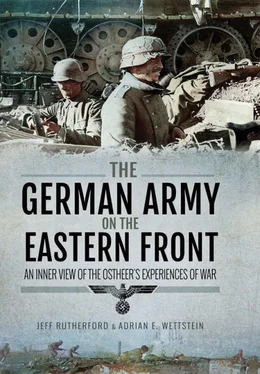At night, elements of the 14th Panzer Division were able to advance through the Tractor Factory to the Volga River.
8.30am: The army commander presented to Major Knetsch, Commander Infantry Regiment 545 (389th Infantry Division) the Knight’s Cross, as well as the German Cross in Gold at his command post. At the same time, he also presented the German Cross in Gold to Oberst Schuster-Woldan, commander Artillery Regiment 389.
Further forces of the 14th Panzer Division and 305th Infantry Division have reached the Volga.
9.00am: In a meeting with [the] commanding general LIst Army Corps, commander 389th Infantry Division, 305th Infantry Division, and 14th Panzer Division, the army commander decided on the plan for the further attack.
The 305th Infantry Division and the 14th Panzer Division will attack on both sides of the railroad south of the Tractor Factory along the Volga. Elements of the 24th Panzer Division and the 14th Panzer Division should tie down their opponents on the flank by attacks from the west.
10.00am: The army chief reports to the army commander for verbal report and consultation on the forward command post.
11.30am–12.30pm: Ride accompanied by the commander 14th Panzer Division to the regimental command post of Panzer Grenadier Regiment 103 in a shelter west of Barrikady. The commanders of Panzer Grenadier Regiment 103 and Panzer Regiment 36 report on the breakthrough to the Volga.
14.00: Meeting with commanding general LIst Army Corps, commander 14th Panzer Division and the Chief [of Staff of] Sixth Army. Commanding general LIst Army Corps has concerns about an immediate attack without regrouping.
The army commander ordered: The attack south of the Tractor Factory will be continued early on 16 October.
Around 16.00 hrs. Return to quarters at the 389th Infantry Division’s command post.
The advance by Panzer Grenadier Regiment 103 to the Volga, one of the most successful German attacks in Stalingrad, created a new situation for Sixth Army. Paulus visited the front sector the day after the attack and conferred with the commanders present there – not only his direct subordinate, General der Artillerie Walther von Seydlitz-Kurzbach, commander of LIst Army Corps, but also with divisional and even regimental commanders. After getting a clearer picture of the situation on the ground, he decided on the follow-up attack on 16 October. In addition to that, but no less important, was his personal handing-over of high awards to two commanders, underlining his recognition of their achievements, and thereby strengthening the esprit de corps . The same can be seen in his front tour on 29 October, this time visiting XIVth Panzer Corps, which was primarily fighting on Sixth Army’s northern flank. [22]
13.00: Drive to the command post of the XIVth Panzer Corps in the ravine Dessyat north-west Gorodishche. The army commander congratulated the commanding general on his promotion to General der Panzertruppen and on his birthday, and at the command post he speaks to the divisional commanders and artillery commanders of the corps who were present there. (14.00 departure)
Other aspects of such tours focused on inter-service cooperation and understanding the capabilities of new weapons, as the tour report of 1 November indicates: [23]
7:45am: Take-off accompanied by the Chief of Staff to the advanced landing field of the VIIIth Air Corps [at] Station Rasguljajewka.
8.30am: Arrival at the advanced command post of the VIIIth Air Corps at the brickyard Rasguljajewka. The commanding general and chief of the LIst Army Corps are present. A short time later, the commander of the Air Fleet 4 and the commanding general of the VIIIth Air Corps arrived. After a long discussion
11.15am: Drive to Assault Gun Battalion 244 southeast of Gumrak Station.
The newly arrived self-propelled heavy infantry guns are demonstrated to the army commander. The battery leader points out various deficiencies. In his opinion, the gun is a makeshift solution which is not yet fully developed. Poor sight for the driver and gunner, low extent of traverse and vulnerability do not allow the use in the manner of the assault guns.
Continuation to the divisional command post of the 295th Infantry Division and discussion with divisional commander.
1pm: Arrival at the command post of the LIst Army Corps [at] Station Gumrak at the same time with the returning Generaloberst von Richthofen. The army commander has a second conversation with him.
14.00: The commanding general of the XIVth Panzer Corps and the commander of the 305th Infantry Division arrive for a verbal report and consultation with the army commander-in-chief and commanding general.
3pm: Return flight to Army Headquarters.
Similar events occurred at all levels of the army, as the following notes of the commander of 205th Infantry Division, Generalmajor Paul Seyffardt, during a visit to the front positions of his troops in Velizh, reveal: [24]
I a: Inadequate entrenchment, especially in the eastern section: the main combat line is not yet continuous everywhere, confusing foreground without wire entanglements and mines. Individual masts and so on offer the enemy good target points. The trenches are generally flat, there are no masks from the sections that could be seen by the enemy (Velizh creek ravine). No sap blocks. Poor bunkers without splinter-proof ceilings. Combat positions without side limitation of the firing field and sufficient splinter protection. Machine guns can partly not shoot over the ditch border.
Only one trench mirror per company. Telescopic sights are haphazardly passed around instead of remaining in the hands of a good rifleman.
There is a lack of tight time and work organization, which is often left at discretion of individual group leaders. Therefore, no sufficient sleep breaks. A rifleman stood as a sentry for 9 hours.
The forward [artillery] observer in the hospital did not have a signal pistol and flares, and explained that not he but the company commander was responsible for the triggering of the barrage. In the trenches of the east section cans, etc., lay strewn around. Usually the trenches were not stabilized with planks. Ammunition not properly stored. Insufficient and dirty maps and plans.
The divisional commander intends to have the officers of the Infantry Regiment 353 view model positions at the other regiments and to demand deadlines for further entrenchment.
I b: Fountains!
Torn clothes, missing shoulder straps (regimental paymaster has to report on 6.10. at 12.00 at the division commander). Cold-resistant oil is supposedly already stored in the eastern section.
Weapons and equipment officer: weapon maintenance and storage leave something to be desired. Collect cartridges! There is a lack of German hand grenades and rifle grenades.
Engineer officer: There is a lack of wire, mine plans (supposedly there are still unrecorded minefields of the Infantry Regiment 257, of which nobody knows). Also desired are detonating fuses, gallery cases, electric fuses.
II a: Officers and men often unshaven, negligent uniforms (rolled-up long trousers). Misuse of awards. Think of proven NCOs and men!
IV b: The sick room in the hospital was unfriendly and unclean. Each soldier should be deloused at least once a month.
Seyffardt noted many details that required improvement through the efforts of his staff officers. They included tactical aspects, but also many disciplinary issues. He also had an eye for leadership deficiencies, such as leaving men on guard duty for too long, or unclean rooms in the field hospital, which had negative effects on both combat morale and the health of the troops.
Finally, there will be a closer examination of the men commanding at the mid-level of the German army in the east, that is battalion to corps level, exemplified by the career of three officers.
Читать дальше






![John Stieber - Against the Odds - Survival on the Russian Front 1944-1945 [2nd Edition]](/books/405234/john-stieber-against-the-odds-survival-on-the-russian-front-1944-1945-2nd-edition-thumb.webp)





